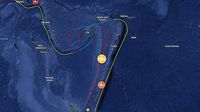A powerful 6.5 magnitude earthquake struck south of the Fiji Islands on April 13, 2025, at 20:03 UTC, as reported by the United States Geological Survey (USGS). This significant seismic event was recorded at a depth of 270 kilometers (168 miles), although the European-Mediterranean Seismological Centre (EMSC) reported a slightly shallower depth of 262 kilometers (163 miles).
The epicenter of the quake was located approximately 617 kilometers (383 miles) south-southwest of Houma, Tonga, and about 934 kilometers (580 miles) southeast of Suva, Fiji. Despite the earthquake's considerable magnitude, the US Tsunami Warning System confirmed that there is no tsunami threat due to the quake's deep-sea origin.
In the aftermath of the earthquake, the USGS issued a Green alert, indicating a low likelihood of casualties and damage. According to their assessment, the likelihood of fatalities and economic losses is minimal, and there are likely to be no affected structures in the region.
Fiji, known for its breathtaking landscapes and pristine beaches, welcomed nearly one million tourists in 2024, making it a beloved holiday destination in the South Pacific. The islands are part of the Pacific "Ring of Fire," a seismically active area where tectonic plates frequently interact, leading to earthquakes and volcanic activity.
Interestingly, the earthquake in Fiji comes on the heels of a devastating 7.7 magnitude quake that struck Myanmar on March 28, 2025. That event left over 4,500 people injured and 441 unaccounted for, highlighting the unpredictable nature of seismic events in different parts of the world.
Later in the day on April 13, 2025, a smaller 5.1 magnitude earthquake was recorded at 4:40 PM local time in the Kermadec Islands region, with a depth of 55.8 kilometers. This adds to the ongoing seismic activity in the Pacific region, which has seen a series of tremors recently.
Reports indicate that tremors from the 6.5 magnitude quake were felt in several parts of Fiji, including the Lautoka Islands, although no significant damage has been reported. The USGS has not received any reports of individuals feeling the earthquake at the time of publication.
The region's geological activity is a reminder of the dynamic nature of the Earth's crust, particularly in areas where tectonic plates converge. This convergence is a common cause of earthquakes, and Fiji's location makes it particularly susceptible to such events.
In addition to the seismic events in Fiji, the world has been witnessing other significant earthquakes. For instance, a 7.1 magnitude earthquake occurred near Tonga and Niue in the Pacific Ocean last month, prompting a tsunami warning. In April, a 6.9 magnitude quake rattled Papua New Guinea, also triggering tsunami alerts for coastal areas.
As scientists continue to monitor seismic activity in the Pacific, the recent earthquake in Fiji serves as a crucial reminder of the need for preparedness in earthquake-prone regions. With millions of tourists flocking to the islands each year, understanding the risks associated with living and visiting such geologically active areas is essential.
Fiji's allure as a tropical paradise remains undiminished, even in the face of natural disasters. The islands' stunning coral reefs and vibrant marine life continue to draw travelers from around the globe, eager to experience the beauty and tranquility that Fiji offers.
In conclusion, while the 6.5 magnitude earthquake south of Fiji Islands on April 13, 2025, was significant, the lack of a tsunami threat and the low likelihood of casualties have provided some reassurance to residents and visitors alike. As the region continues to experience seismic activity, the importance of ongoing monitoring and preparedness remains paramount.










